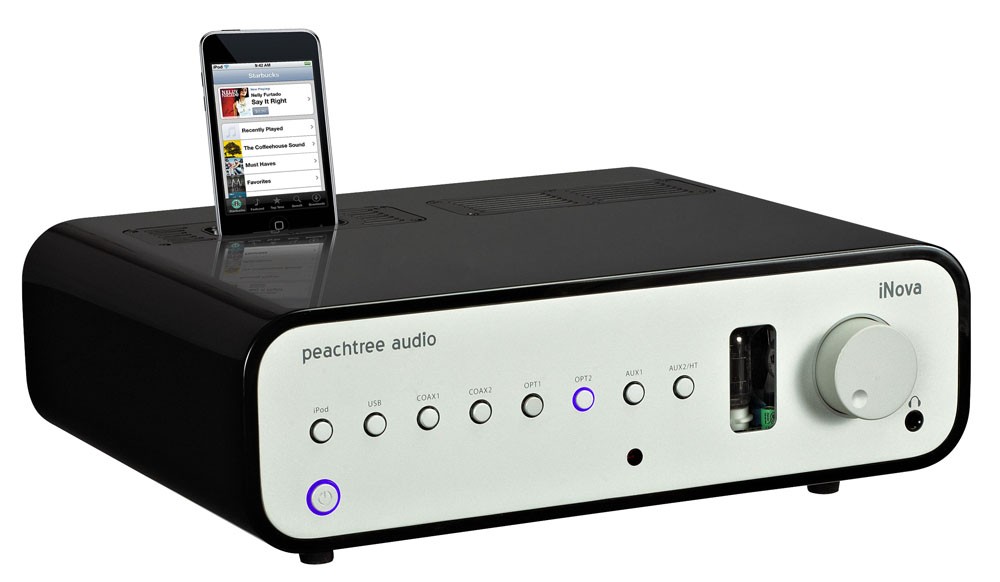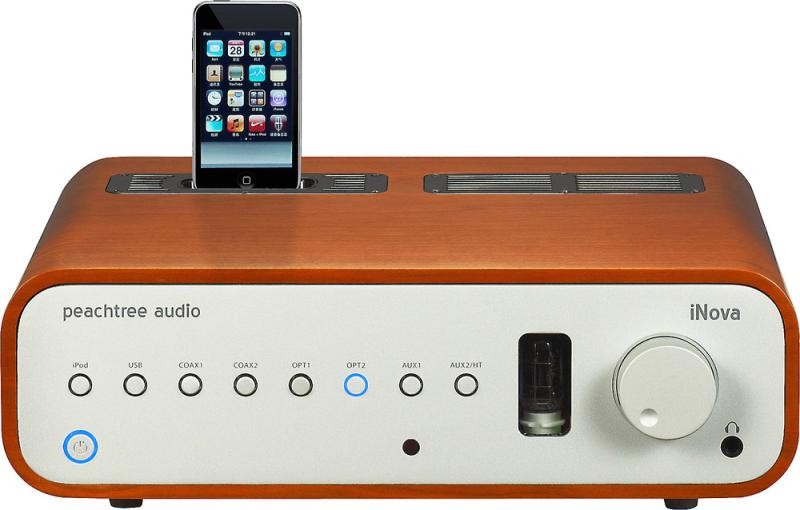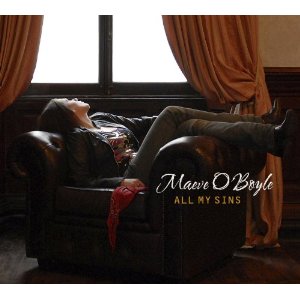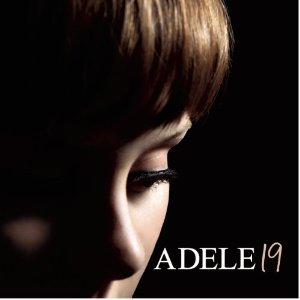Peachtree Audio’s iNova
| Peachtree Audio’s iNova |
| Art for Music’s Sake, or Versatility Be Thy Name |
|
|
|
October, 2011 |

The beginning of my computer audio journey
Let me say that I was a computer audio neophyte. No, that’s wrong. I was a computer audio virgin until I received a Peachtree Audio iNova for audition. I first set eyes on the iNova at a recent Gotham City Audio Society meeting. Jon Zimmer, a representative for Peachtree Audio (among other audio companies), was explaining the many features of the unit. The more he talked about the iNova’s digital capabilities, the more my head started spinning. While I’m not new to digital playback, having owned several CD players and external DACs since the early 1990s, I had no idea what Jon was saying concerning the computer aspects of the unit. I decided then and there to borrow an iNova for review, and to finally embrace computer audio. A quick call to David Solomon of Peachtree Audio and ERA speakers resulted in a package at my door step a few days later.
After removing the packaging, I couldn’t hide my joy at how aesthetically attractive the iNova is in Cherry wood. The unit also comes in Rosewood or Black Gloss, if Cherry doesn’t tickle your fancy. To borrow and modify 10 CC’s terrific song title, the iNova is art for music’s sake. I really like the rounded corners and the circular blue source lights of the unit. If you love (like I do) either the Art Deco, Bauhaus, or modern Scandinavian design periods and have decorated your abode as such, then Peachtree Audio products would serve as a fitting complementary piece to the rest of your furnishings. The iNova would look super cool sitting on a Wolfgang Hoffman end table, while you are sitting smartly in a L.M. Van der Rohe chair and listening to what else? The band Bauhaus of course! And if you happen to live with a significant other, she or he would probably comment positively on its attractiveness. You might get enough brownie points for a special treat later in the night, if you know what I mean. That is, unless your significant other prefers American colonial or Victorian design motifs instead, which means you probably end up in the dog house.
I connected the unit to my bedroom system and let it burn in for several days. In the meantime, I went on the web to learn some basics of computer audio. I am proud to announce that I now have a rudimentary knowledge of this fairly new audio medium. I am ready to be inducted into the computer audio nerd society as a newly minted neophyte. Live long and prosper!
Peeking inside the enclosure
Exactly what is an iNova? Is it an audio superhero dressed in a designer suit? Is it a whiz-bang all encompassing electronic laser robotron that will save the world from the evil low fidelity empire? It’s partly those things but the true identity is behind door number three. The iNova actually belongs to a growing group of audio products which contain several components in a single chassis. Oh, you mean your parents or you had something like this twenty, thirty, or forty years ago? Well, yes sort of. Just in the past few years, companies such as Bel Canto, Bryston , to Naim a few (pun intended) have joined the band wagon to produce what is the twenty-first century’s version of the stereo integrated amplifier, but with more digital versatility. These modern all-in-one box units usually have an internal DAC, and in this case an iPod dock as well. Turn your flashlight on, and let’s take a peek inside to see the different components.
Preamplifier section – It is a hybrid design (6N1P tube) with a Class A output stage. The 6N1P tube is similar to the popular 6DJ8 or 6922 tube types, but has higher heater and plate voltage making it a more robust tube. If you’re a strictly solid-state kind of listener, the tube circuit can be switched off via a button on the remote control. What a nifty feature! The engineers at Peachtree have thought seriously about the inherent noise of a computer’s CPU or noise from digital switching power supplies, so each digital input in the iNova is transformer coupled. This ground isolation of the USB, coaxial or optical digital inputs is to eliminate noise from reaching the output, so the signal fundamentally remains as pure as possible, my dear Watson.
Amplifier section – power is supplied by a solid state MOSFET amplifier, rated at 80 wpc into 6 ohms. If your speakers are nominally 8 ohms, then the amplifier is probably putting out around 60 wpc. If one is using loudspeakers of at least moderate efficiency (around 86 db) in a moderate size room (e.g. 16’ x 20’ with 9’ceiling), there should be no problems with the iNova driving them. It may be a problem for owners of large planar or electrostatic loudspeakers, which have a tendency to dip far below 4 ohms at times. I think the iNova will drive these types of power hungry speakers to a fairly loud volume, but dynamics and impact may suffer. Since I don’t have either type of speaker on hand, I could not verify my suspicion. For owners of these types of speakers, the iNova has a feature which will rectify the problem. Read on and you will be rewarded.
I first used my pair of Heybrook HB 150s, a two-way, stand-mounted cone speaker of 88 db efficiency, nominally rated at 6 ohms, and the iNova delivered plenty of power and dynamics in my 14 1/2’ x 18 1/2’living room with a 10’ ceiling. I also listened with my two way AAD 2001 monitor speakers (86 db efficiency at 8 ohms), which required slightly more gain. Even with the ADD speakers, I never had to turn past 11 o’clock on the volume knob to achieve a satisfyingly loud level.
Internal DAC – Hey buddy, you got two bits? You bet! Even better, I can give you 32-bits from ESS Technology. The iNova incorporates an ESS ES9016 digital-to-analog converter from the Sabre family of 32-bit chips, with jitter reducing technology. I have heard other units using the ESS Sabre ES9018 reference chip, most notably the Eastern Electric and Buffalo (by Twisted Pear Audio) DACs. From my experience, what all these Sabre equipped units share in common is the ability to present a smooth treble and gobs of detail, with a low noise floor. There is a button on the iNova’s back panel for the user to select whether or not to use digital filtering. When the button is pushed in there is no filtering or oversampling (i.e. NOS), and when the button is out there is oversampling up to 24 bits/192 kHz via coaxial or optical. In effect, one is getting two DACs for the price of one. Who says you can’t have your cake and eat it too?
Headphone amp – No need to buy a separate headphone amplifier, since the iNova conveniently provides one for you, which is shared with the preamp class A output stage. You can listen on your cans with or without the tube in the circuit. It is fitted with a standard ¼ inch jack. No wimpy mini-jack on this baby. Plugging in headphones will automatically mute the loudspeakers, so the neighbors won’t pound on your wall at 3 in the morning if you live in an apartment. You hear that #4D? Quiet!
iPod dock – As far as I know, Peachtree is the first high-end audio company to provide a direct digital iPod dock on an integrated amp (iNova, iDecco, and Musicbox). According to the Peachtree website, the iNova dock (with iPod attached) is sending the digital numerical data directly to its internal DAC, while other docks are merely passing the analog signals. The company calls this “Pure Digital.”
Remote control – The remote control is covered in a smooth rubbery material and is very tactile to the touch. If you are a “touchy, feely” type, you will enjoy caressing the remote, eh, never mind. Besides the buttons I’ve already mentioned, the other buttons are basic to the operation of the iNova: mute, volume, the eight inputs, and simple commands for the iPod.

Features/functions
The iNova has no on/off switch or power button. When the power cord is plugged into an electrical outlet the unit automatically starts in standby mode, evidenced by a circular red glow around the standby button. When in standby, either push the button on the unit, or, the power button on the remote to go into play mode.
There are eight inputs, corresponding to the eight pushbuttons on the front panel, of which six are digital based (iPod, USB, 2 coaxial, 2 optical). The two analog inputs are labeled aux1 and aux2/HT; enabling the latter to be used as a home theater bypass. There’s a push button on the back panel to switch between aux2 and HT bypass. It would be even better if the switching was included on the remote control. Both analog inputs can accommodate analog sources like a tuner, tape or cassette deck, CD or DVD player via their RCA output, or phonostage/turntable. Don’t have any of those contraptions? Why don’t you ask gramps, or ask that young whippersnapper grandson to lend you his turntable?

As for the digital inputs, the possibilities are staggering with digital or satellite tuners, SACD or DVD players, CD players, Apple TV or other streaming audio products, Logitech Squeezebox, Sonos zone player, high resolution files from your computer/laptop or music server, or iPod. There are probably a few more down the not too distant road.
While this array of input options in no way rivals the complexities of a Formula 1 car’s electronic steering wheel (and wouldn’t I love to drive one of those!), it nevertheless can get complicated if one is to use all the inputs with all the available analog and digital sources. At least there will be spaghetti all over the back panel.
The output choices are more limited, but still more than the average all-in-one audio product. Looking at the back panel, there is a pair of quality speaker terminals, able to accommodate spade, banana, bare wire or any combination thereof.
Want to watch videos stored on your iPod from your TV monitor? It’s as easy as 1-2-3, by connecting a set of component video cables via the video output jacks on the iNova into the input jacks of your TV monitor or AV receiver or processor. You can now view the latest viral videos from YouTube.
The pre out jacks allow for adding either a subwoofer or a power amplifier. So if you do have electrostatic or planar speakers, and really like the versatility of the iNova but feel the internal amplifier doesn’t have enough oomph, just connect the latest Megatron 5000 watt amp and you’re ready to bleed out your ears.
If the user wants to use the iNova strictly as a high quality DAC, just connect a CD transport or CDP into the iNova and then connect the RCA line out on the back panel into the inputs of a separate preamp or integrated amp. In total, that’s a wagonload of components and features for your $1,800 greenbacks. You can sleep tight tonight knowing you got more than your money’s worth.
Listening Impressions
I started the listening sessions using my OPPO 981 digital coaxial output into the iNova’s input, thus utilizing its internal Sabre DAC, and later switching to the OPPO 24 bit/192 khz DAC via analog (RCA to RCA) for comparison. Listening to Bettie Serveert’s “You’re Changed” on the band’s Attagirl [Minty Fresh] on the iNova DAC, vocals were slightly more analog sounding (smoother), sibilance was less exaggerated, and the background was quieter. In contrast, the OPPO’s DAC emphasized the treble region more, and the overall sound was more neutral and solid state (even with the tube in). Similar sonic differences resulted with Chrisette Michele’s lovely “Your Joy” on her 2007 album, I Am [Def Jam] about a father’s adoration of his daughter. Bass was tight and defined on both CDs, though impact could be better. Next on the listening queue was Gershwin’s Rhapsody In Blue, Andre Kostelanetz conducting [Sony]. Instrumental timbres and textures sounded slightly different between the respective DACs. Again, the sonic differences were that the Sabre DAC sounded more analog and smoother. This was a toss-up as to which I liked better. Timing, pace and rhythm on all CDs played were compelling regardless of the DAC used. The tube circuit seemed to warm up vocals and strings more than other instruments.
After listening to several more selections, I came to the conclusion that I prefer the iNova’s Sabre DAC over OPPO’s DAC on the vast majority of songs I played, especially with brighter recordings. There isn’t a right or wrong sound. It really depends on the listener’s preference. It’s my duty to inform the readership what I hear and it’s up to the listener after reading the review to decide if a particular product might be suitable for an audition. I’m just stating my preference.
Next up I compared the optical (Toslink) versus coaxial (S/PDIF) versus the RCA (analog) inputs. It was an easy experiment, since all I had to do was connect the various cables in the back of the OPPO 981 player, and switch sources via the remote. With the tube circuit in, and playing the same selections revealed the musical presentation from the optical input fell somewhere between that of the coaxial and RCA inputs, i.e. slightly warmer sounding than the RCAs, but slightly more neutral than the coaxial cable. Vocal presence was better and instrumental timbres were more natural with the coaxial than either the optical or RCA cables. The tonal differences were not night and day but clearly discernable. I think the major difference in sound between the coaxial and optical inputs were attributed to my much more expensive coaxial pitted against a generic, inexpensive optical cable. I repeated this listening comparison with headphones. I’m not a headphone aficionado, so the cans I had on hand were not expensive. The headphone results were consistent with what I heard from the speakers, with the coaxial input providing more presence and smoothness.
I experimented with the digital filter button on the back panel with the same tracks, alternating between NOS and oversampling. With non-oversampling (NOS), the sonic differences were even more slight or none among the three different inputs, with or without tube in the circuit. When compared with oversampling, the NOS mode loss some resolution and detail. The NOS mode may be better for brighter recordings in terms of listenability. Bravo to Peachtree for giving us the option! Though I prefer the oversampling setting, it’s really up to the individual listener to determine which “sonic signature” is preferable.
Up next, I connected a generic USB cable from my Sony Vaio laptop to the iNova and listened to streaming music and live concerts on NPR and WFUV online. One of my favorite new artists is Adele, and NPR has several archived live recordings of this immensely popular artist. I also listened to a live Martin Sexton concert on WFUV. Since this is my first foray in computer audio, I didn’t have any preconceived notions of sound quality from this medium. I found the overall sound quality on both stations to be good or very good. Vocal presence of both performers was fairly palpable. I’ve read the USB interface (in theory) is not the best solution for digital sound because it is not continuous, but instead sends packets of data. The sound quality from streaming radio on WFUV and Pandora were not nearly as good, and lacked some detail. The soundstage was two dimensional and was a tonally flat version of CDs, which the iNova easily distinguished. I’m not sure why the live concerts sounded better than the streaming music. Perhaps someone more verse in computer audio could provide an explanation.

I had on hand Maeve O’Boyle’s All My Sins [Linn Records], in both the 24 bit/88.2khz (digital files) and 16 bit/44.1khz (Redbook CD) versions. Comparing them I found the higher resolution files were slightly cleaner sounding and vocals were somewhat smoother than the Redbook CD. On some tracks, there was a noticeable improvement with hearing into the recording environment, and on other tracks I heard no difference at all. Again, the iNova was able to distinguish any sonic differences.

I connected the iNova’s line out to my modified Jolida tube integrated amp, to use as a standalone DAC. While the iNova’s preamp and amp sections are certainly “bang for the buck,” its Sabre DAC is outstanding. The DAC has the see-through transparency and resolution that rivals the best DACs I’ve heard. Listening to Adele’s “Daydreamer” on her excellent album 19[Columbia], her minor changes in vocal inflections are beautifully captured by the Sabre DAC.
Lastly, I tried the iPod dock. Initially I couldn’t get my 3rd generation iPod touch to work on the dock. Frustrated, I disconnected and reconnected the iNova’s power cord, while also rebooting the iPod. I reconnected and voila, we have ignition! My iPod is loaded with WAV lossless files, and I was able to boogie to Weezer2, the green album [Interscope Records]. The iPod sounded as good as my CD version. When I tried switching albums, the iNova stopped picking up the signal again. Even though the owner’s manual states (top of page 8) the iNova supports 1st and 2nd generation iPod models only, I was assured by David Solomon (via email) that the latest generation models will work. I went through the procedure again, and was able to get sound again. The connection is a little finicky and if you accidently move your iPod a little too much, the sound is lost. The solution is to reconnect or reboot iPod, or both iNova and iPod.
Summary
Sonically, detail retrieval from good recordings was excellent. The iNova presented a clean, transparent but not clinical sound. On mediocre and compressed recordings, there was no euphonic enhancement to “sweeten” the flaws. For listeners who prefer music in this fashion, I suggest to look elsewhere. The iNova does not sound especially warm; rather it is a thoroughly modern and fairly neutral sounding hybrid integrated. Its tube buffer adds some warmth in the mid-range for more presence and dimensionality, especially with vocals.
According to David Solomon, the company “started after realizing audio sources would change over to computers and streamers. We saw few in the industry who were gearing up to meet the need of the impending market merger.” I think Peachtree has hit a home run. There are now hundreds of millions of iPod and computer owners in the world, almost all with crappy desktop audio systems or none at all. This is a huge market to tap into. With the addition of decent speakers, the iNova allows low fidelity users to bypass mid fidelity and go directly to Park Place; I mean high end sound.
Overall, the iNova is truly an outstanding audio product with a near world class DAC, and I can’t think of anything else that will provide such musicality and versatility at a middling price. I really enjoyed and had a lot of fun with the iNova not only because of its multiple functions, but also because it introduced me to quality computer audio. Given the price versus features and performance index the value is sky high. Plus it’s so darn cute! All of which garners a strong recommendation for audition.
Now that I have had a taste of computer audio, all I can say is “I’ll be back,” to paraphrase the Arnold in The Terminator. Until next time, I wish you happy listening. 
![]()
Specifications:
Amplifier
ST MOSFET amp modules 80 watts per channel at less than .1% distortion into 6 ohms 20Hz-20kHz
Sigma Servo internal wiring configuration for better damping.
Preamplifier
Hybrid tube design (6N1P) 7.0V output @ 2.0V input
<1 ohm at output stage
Class A output stage
Polypropylene caps in the signal path
Headphone Amp (shared with the Pre Out stage)
Suitable for all electrodynamic headphones
Output impedance: <1 ohm
Maximum output power:100mW into 8 ohms / 300mW into
150 ohms / 150mW into 300 ohms
Class A output stage
6N1P vacuum tube in circuit
DAC
Digital inputs 6 total. 1 USB, 2 Coax, 2 Optical, 1 iPod dock
ESS ES9016 Sabre32 Ultra DAC
USB 24Bit/96kHz
SPDIF 24Bit/192kHz
11 regulated power supplies
Class A output stage
Transformer-coupled digital inputs for ground isolation
Galvanically-isolated USB stage
>122dB signal to noise ratio (w/o tube)
<3 picoseconds jitter measured at the master clock
Dimensions: 5” H x 14 3⁄4” W x 14” D
(including volume knob and speaker terminals)
Weight: 26 pounds
Finishes: Black Gloss, Rosewood, Cherry
Price: $1,799
Company Information:
David Solomon
VP Sales and Marketing
Managing Partner
Peachtree Audio
Address: 2045 120th Ave, NE, Bellevue WA 98005
Telephone: 770-649-9544
Email: DavidS@peachtree.com
Company website: www.peachtreeaudio.com
![]()
Don’t forget to bookmark us! (CTRL-SHFT-D)
Stereo Times Masthead
Publisher/Founder
Clement Perry
Editor
Dave Thomas
Senior Editors
Frank Alles, Mike Girardi, Russell Lichter, Terry London, Moreno Mitchell, Paul Szabady, Bill Wells, Mike Wright, and Stephen Yan,
Current Contributors
David Abramson, Tim Barrall, Dave Allison, Ron Cook, Lewis Dardick, John Hoffman, Dan Secula, Don Shaulis, Greg Simmons, Eric Teh, Greg Voth, Richard Willie, Ed Van Winkle, Rob Dockery, Richard Doran, and Daveed Turek
Site Management Clement Perry
Ad Designer: Martin Perry





Be the first to comment on: Peachtree Audio’s iNova